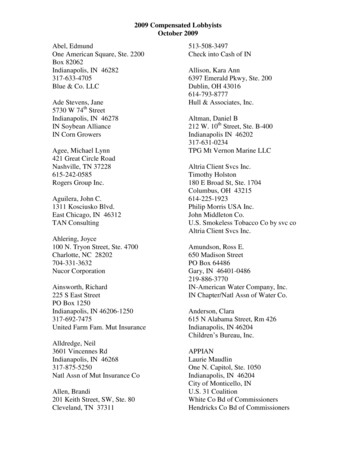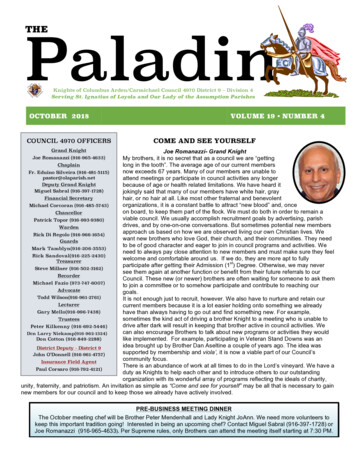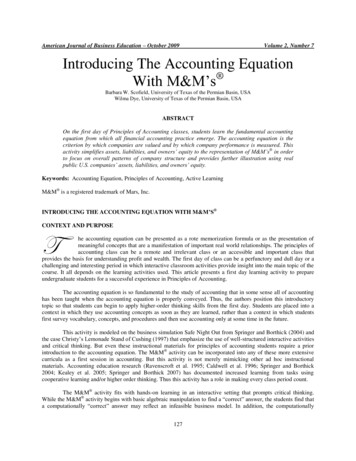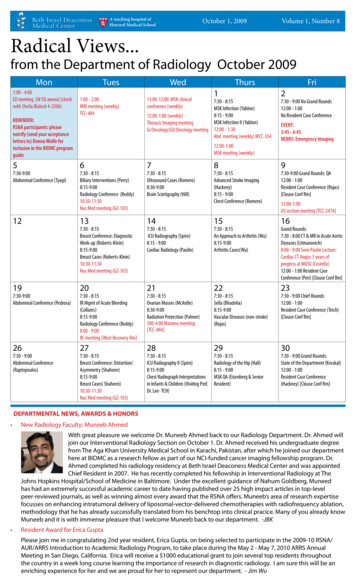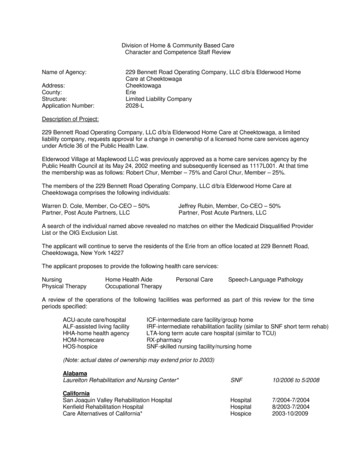
Transcription
October 20, 2009 (XIX:8)Stanley Kubrick LOLITA (1962, 152 min)Directed by Stanley KubrickScreenplay by Vladimir Nabokov & Stanley KubrickBased on the novel by Vladimir NabokovOriginal Music by Nelson RiddleCinematography by Oswald MorrisJames Mason.Prof. Humbert HumbertShelley Winters.Charlotte HazeSue Lyon. LolitaPeter Sellers. Clare QuiltySTANLEY KUBRICK (26 July 1928, New York City, New York,USA—7 March 1999, Harpenden, Hertfordshire, England, UK,natural causes) direct 16, wrote 12, produced 11 and shot 5 films:Eyes Wide Shut (1999), Full Metal Jacket (1987), The Shining(1980), Barry Lyndon (1975), A Clockwork Orange (1971), 2001:A Space Odyssey (1968), Dr. Strangelove or: How I Learned toStop Worrying and Love the Bomb (1964), Lolita (1962),Spartacus (1960), Paths of Glory (1957), The Killing (1956),Killer's Kiss (1955), The Seafarers (1953), Fear and Desire(1953), Day of the Fight (1951), Flying Padre: An RKO-PatheScreenliner (1951). Won Oscar: Best Effects, Special VisualEffects- 2001: A Space Odyssey (1969); Nominated Oscar: BestWriting, Screenplay Based on Material from Another MediumDr. Strangelove or: How I Learned to Stop Worrying and Lovethe Bomb (1965); Nominated Oscar: Best Picture- Dr. Strangeloveor: How I Learned to Stop Worrying and Love the Bomb (1965);Nominated Oscar: Best Director- Dr. Strangelove or: How ILearned to Stop Worrying and Love the Bomb (1965); NominatedOscar: Best Writing, Story and Screenplay - Written Directly forthe Screen- 2001: A Space Odyssey (1969); Nominated Oscar:Best Director- 2001: A Space Odyssey (1969); Nominated Oscar:Best Writing, Screenplay Based on Material from AnotherMedium- A Clockwork Orange (1972); Nominated Oscar: BestPicture- A Clockwork Orange (1972); Nominated Oscar: BestDirector- A Clockwork Orange (1972); Nominated Oscar: BestWriting, Screenplay Adapted From Other Material- Barry Lyndon(1976); Nominated Oscar: Best Picture- Barry Lyndon (1976);Nominated Oscar: Best Director- Barry Lyndon (1976);Nominated Oscar: Best Writing, Screenplay Based on Materialfrom Another Medium- Full Metal Jacket (1988).VLADIMIR VLADIMIROVICH NABOKOV (Russian: ВладимирВладимирович Набоков, (22 April 1899, Saint Petersburg —2July 1977, Montreux) “was a multilingual Russian novelist andshort story writer. Nabokov wrote his first nine novels in Russian,then rose to international prominence as a master English prosestylist. He also made contributions to entomology and had aninterest in chess problems. Nabokov's Lolita (1955) is frequentlycited as amongst his most important novels, and is his mostwidely known, exhibitingthe love of intricate wordplay and descriptivedetail that characterizedall his works. The novelwas ranked at #4 in thelist of the Modern Library100 Best Novels by theModern Library. Hismemoir entitled Speak,Memory was listed #8 onthe Modern Librarynonfiction list”(Wikipedia). Some of his other novels are The Defense (1934,English trans 1964), Laughter in the Dark (1933, Eng. trans1938),Invitation to a Beheading (1936, Eng. Tr ans. 1959, The Gift(1938, Eng. Trans. 1963), The Real Life of Sebastian Knight(1941), Bend Sinister (1947), Pnin (1957), Pale Fire (1962), Adaor Ardor: A Family Chronicle (1966). He is also the author ofseveral short story collections, 11 volumes of poetry, a 1923
Kubrick—LOLITA—2translation of Alice’s Adventures inWonderland into Russian, andseveral translations of Russian classics into English, severalvolumes of criticism. Several volumes of autobiography, and aclassic work on butterflies. Three volumes of Library of Americaare devoted to his novels and memoirs.JAMES MASON (15 May 1909, Huddersfield, Yorkshire, England,UK—27 July 1984, Lausanne, Switzerland, heart attack) acted in151 films, some of which were The Assisi Underground (1985),The Shooting Party (1985), Yellowbeard (1983), The Verdict(1982), Socrates (1982), Salem's Lot (1979), Murder by Decree(1979), The Boys from Brazil (1978), Heaven Can Wait (1978),Cross of Iron (1977), Voyage of the Damned (1976), Mandingo(1975), Gente di rispetto/The Flower in His Mouth (1975),Frankenstein: The True Story (1973), The MacKintosh Man(1973), The Last of Sheila (1973), The Sea Gull (1968), Mayerling(1968), Georgy Girl (1966), The Blue Max (1966), "Dr. Kildare"(4 episodes, 1965), Genghis Khan (1965), Lord Jim (1965), ThePumpkin Eater (1964), The Fall of the Roman Empire (1964),Lolita (1962), The Trials of Oscar Wilde (1960), "Playhouse 90"(5 episodes, 1957-1960), Journey to the Center of the Earth(1959), North by Northwest (1959), Island in the Sun (1957),Forever, Darling (1956), 20000 Leagues Under the Sea (1954), AStar Is Born (1954), Prince Valiant (1954), The Man Between(1953), Julius Caesar (1953), The Desert Rats (1953), Charade(1953), The Prisoner of Zenda (1952), The Desert Fox: The Storyof Rommel (1951), Pandora and the Flying Dutchman (1951),Madame Bovary (1949), Odd Man Out (1947), The Seventh Veil(1945), Fanny by Gaslight/Man of Evil (1944), Secret Mission(1942), The Night Has Eyes (1942), I Met a Murderer (1939),Bees on the Boat-Deck (1939), The Moon in the Yellow River(1938), Cyrano de Bergerac (1938), Return of the ScarletPimpernel (1937), Fire Over England (1937), The Mill on theFloss (1937), Secret of Stamboul (1936), Late Extra (1935).Nominated Oscar: Best Actor in a Leading Role- A Star Is Born(1955); Nominated Oscar: Best Actor in a Supporting RoleGeorgy Girl (1967); Nominated Oscar: Best Actor in a SupportingRole- The Verdict (1983).SHELLEY WINTERS (18 August 1920, St. Louis, Missouri,USA—14 January 2006, Beverly Hills, California, USA, naturalcauses) aooered ub 157 films, including La bomba (1999),Gideon (1999), "Roseanne" (10 episodes, 1991-1996), ThePortrait of a Lady (1996), Jury Duty (1995), Touch of a Stranger(1990), The Delta Force (1986), Déjà Vu (1985), Fanny Hill(1983), "The Love Boat" (2 episodes, 1982), S.O.B. (1981), "Facethe Music" (1 episode, 1981), "Fridays" (1 episode, 1981), TheMagician of Lublin (1979), Tentacoli/Tentacles (1977), Next Stop,Greenwich Village (1976), Diamonds/Diamond Shaft/Yahlumim(1975), Cleopatra Jones (1973), Blume in Love (1973), ThePoseidon Adventure (1972), Bloody Mama (1970), Buona Sera,Mrs. Campbell (1968), Wild in the Streets (1968), "Batman" (2episodes, 1966), Alfie (1966), Harper (1966), A House Is Not aHome (1964),Wives and Lovers (1963), The Balcony (1963),Lolita (1962), Let No Man Write My Epitaph (1960), OddsAgainst Tomorrow (1959), The Diary of Anne Frank (1959),"Wagon Train" (1 episode, 1957), "The Alcoa Hour" (1 episode,1957), I Died a Thousand Times (1955), The Big Knife (1955), IAm a Camera (1955), The Night of the Hunter (1955), ExecutiveSuite (1954), A Place in the Sun (1951), Frenchie (1950),Winchester '73 (1950), The Great Gatsby (1949), A Double Life(1947), Knickerbocker Holiday (1944), There's Something Abouta Soldier (1943). Won Oscar: Best Actress in a Supporting RoleThe Diary of Anne Frank (1960); Won Oscar: Best Actress in aSupporting Role- A Patch of Blue (1966); Nominated Oscar: BestActress in a Leading Role- A Place in the Sun (1952); NominatedOscar: Best Actress in a Supporting Role- The PoseidonAdventure (1973).SUE LYON (10 July 1946, Davenport, Iowa, USA—) acted in 24films, including Alligator (1980), End of the World (1977), Crash!(1977), Invisible Strangler (1976), "Love, American Style" (2episodes, 1969-1974), Una gota de sangre para moriramando/Clockwork Terror (1973), Tarot/Autopsy/The Magician(1973), Evel Knievel (1971), Four Rode Out (1970), Tony Rome(1967), The Flim-Flam Man (1967), 7 Women (1966), The Nightof the Iguana (1964), and Lolita (1962).PETER SELLERS (8 September 1925, Southsea, Hampshire,England, UK—24 July 1980, London, England, UK, heart attack)acted in 79 films and directed 3. Some of his notable filmappearances were: The Fiendish Plot of Dr. Fu Manchu (1980),Being There (1979), The Prisoner of Zenda (1979), Revenge of thePink Panther (1978), Kingdom of Gifts (1978), The Pink PantherStrikes Again (1976), Murder by Death (1976), The Return of thePink Panther (1975), Alice's Adventures in Wonderland (1972),There's a Girl in My Soup (1970), A Day at the Beach (1970), TheMagic Christian (1969), I Love You, Alice B. Toklas! (1968), TheParty (1968), Casino Royale (1967), What's New Pussycat (1965),A Shot in the Dark (1964), The World of Henry Orient (1964), Dr.Strangelove or: How I Learned to Stop Worrying and Love theBomb (1964), The Pink Panther (1963), Lolita (1962), Waltz ofthe Toreadors (1962), Only Two Can Play (1962), TheMillionairess (1960), The Running Jumping & Standing Still Film(1960), I'm All Right Jack (1959), The Mouse That Roared (1959),tom thumb (1958), The Smallest Show on Earth (1957), Case ofthe Mukkinese Battle-Horn (1956), The Ladykillers (1955), DownAmong the Z Men/The Goon Show Movie (1952), Let's Go Crazy(1951). Nominated Oscar: Best Short Subject, Live ActionSubjects- The Running Jumping & Standing Still Film (1960);Nominated Oscar: Best Actor in a Leading Role- Dr. Strangeloveor: How I Learned to Stop Worrying and Love the Bomb (1965);Nominated Oscar: Best Actor in a Leading Role- Being There(1980).OSWALD MORRIS (22 November 1915, Hillingdon, Middlesex,England, UK—) was cinematographer on 57 films, among themThe Dark Crystal (1982), The Great Muppet Caper (1981), JustTell Me What You Want (1980), The Wiz (1978), Equus (1977),The Seven-Per-Cent Solution (1976), The Man Who Would BeKing (1975), The Man with the Golden Gun (1974), The OdessaFile (1974), The MacKintosh Man (1973), Sleuth (1972), Fiddleron the Roof (1971), Scrooge (1970), Goodbye, Mr. Chips (1969),Oliver! (1968), Reflections in a Golden Eye (1967), The Winter'sTale (1967), The Taming of the Shrew (1967), Stop the World: IWant to Get Off (1966), The Spy Who Came in from the Cold(1965), Life at the Top (1965), The Hill (1965), Of HumanBondage (1964), The Pumpkin Eater (1964), The Ceremony(1963), Come Fly with Me (1963), Term of Trial (1962), Lolita(1962), Satan Never Sleeps/Flight from Terror/The Devil NeverSleeps (1962), The Guns of Navarone (1961), The Entertainer(1960), Our Man in Havana (1959), The Roots of Heaven (1958),The Key (1958), Look Back in Anger (1958), A Farewell to Arms(1957), Heaven Knows, Mr. Allison (1957), Moby Dick (1956),
Kubrick—LOLITA—3The Man Who Never Was (1956), Beau Brummell (1954), Beat theDevil (1953), Moulin Rouge (1952), So Little Time (1952), Circleof Danger (1951), The Adventurers/Fortune in Diamonds (1951),Cairo Road (1950), Golden Salamander (1950). Won Oscar: BestCinematography- Fiddler on the Roof (1972); Nominated Oscar:Best Cinematography- Oliver! (1969); Nominated Oscar: BestCinematography- The Wiz (1979).from Conversations with Wilder. Cameron Crowe. Knopf, NY,1999.“He [Kubrick] has never made a bad picture. Each picture hetrumps the trump.”from World Film Directors V. II. Ed. John Wakeman. TheH.H. Wilson Co. NY 1988. entry by Adrian TurnerAmerican director, producer, and scenarist, was born the Bronx,New York, the son of Jacques and Gertrude Kubrick. His fatherwas a physician, the son of Polish and Romanian Jews. Kubrickattended the William Howard Taft High School. He was not asuccessful student but an ardent chess payer and photographer.His father, also a photographer, had bought him a 35mm stillcamera, and Kubrick’s first break came in April 1945 when achance picture of a newsdealer on the day of Roosevelt’s deathwas bought by Look magazine. At the age of seventeen Kubrickwas hired by Look as a staff photographer.During his four years there, Kubrick received the highereducation he wanted by enrolling as a nonmatriculating student atColumbia University. As Alexander Walker noted, “Dropping outof school made him into a lifelong student.” At the same time,Kubrick was attending screenings at the Museum of Modern Art:“I was aware that I didn’t know anything about making films, butI believed I couldn’t make them any worse than the majority offilms I was seeing. Bad films gave me the courage to try making amovie.”Kubrick’s first effort was Day of the Fight (1951), adocumentary about the boxer Walter Cartier, whom Kubrick hadphotographed for Look. The 16-minute, 35mm film was sold toRKO for a tiny profit and an advance on another short, FlyingPadre (1951), about a priest in New Mexico who tours his parishof 4,000 square miles by small plane. While Flying Padre isconventional program-filler material, Day of the Fight is a verystriking piece of work, a profile couched in the style of film noirwith a highly dramatic commentary (a device Kubrick wouldrepeatedly use in his features) and a vivid, nightmarish sense ofentrapment as Cartier waits in his dressing room for the evening’sfight, along with his identical twin Vincent, a lawyer who acts ashis manager. Richard Combs, reassessing the film in 1980, wrotethat “the timelock structure of course anticipates—and in a waybests—The Killing; the deserted, early morning streets are ashaunted as the similarly used locations in Killer’s Kiss. But thefilm’s most extraordinary visual trouvaille is also its mostmundane. The glum-faced Cartier twins, waking in the same bedin the morning, walking to communion, sharing the anxieties and(reputedly) the physical pain of the fight .”After seeing his first films released, Kubrick resignedfrom Look. He made a third short, The Seafarers (1953), about theSeafarers’ International Union, then embarked on his first feature,Fear and Desire (1953). Kubrick told Joseph Gelmis, “I was thecamera operator and director and just about everything else. Thefilm was shot in 35mm without a soundtrack. The dubbing was abig mistake on my part; the actual shooting cost was 9000, butbecause I didn’t know what I was doing with the soundtrack itcost me another 30,000. Fear and Desire played the art housecircuits, and some of the reviews were amazingly good, but it’snot a film I remember with any pride, except for the fact it wasfinished.”The script was written by Kubrick’s friend HowardSackler (who later wrote The Great White Hope) and resumed thetheme of “twins” or doubles already adumbrated in Day of theFight. Two American soldiers, lost in some wilderness, confronttwo enemy soldiers who are, however, played by the same actors.The intellectual Lieutenant Corby (Kenneth Harp) symbolicallydestroys himself by killing his double; the more primitive Mae(Frank Silvera), drifting downstream on a raft, manages tostruggle through to psychic wholeness.In a letter to the film’s distributor, Joseph Burstyn,Kubrick described the film thus: “Its structure: allegorical. Itsconception: poetic. A drama of ‘man’ lost in a hostile world,seeking his way to an understanding of himself and life aroundhim. He is further imperiled on his odyssey by an unseen butdeadly enemy that surrounds him; but an enemy who, uponscrutiny, seems to be almost shaped from the same mold. It will,probably, mean many things to different people, and it ought to.”Kubrick might have been describing any one of his later films,especially 2001: A Space Odyssey (1968) and The Shining, sincethe letter alludes to his fondness for ambiguity and metaphor,evoking the Kubrickian universe of entrapment and immortality:man does not progress but merely perpetuates ancient, instinctiveevils .Fear and Desire was financed privately, as was Kubrick’snext feature, Killer’s Kiss (1955). Again, Kubrick was a virtualone-man crew and co-wrote the script with Sackler. The film wasbought by United Artists, the most progressive Hollywooddistributor of the 1950s .Beginning his study of Kubrick, Alexander Walker wrotethat “only a few directors possess a conceptual talent–that is, atalent to crystallize every film they make into a cinematic concept.It transcends the need to find a good story. An absorbing story.Itis the talent to construct a form that will exhibit the maker’s visionin an unexpected way. It is this conceptual talent that mostdistinguishes Stanley Kubrick.”Early signs of this talent in Killer’s Kiss did not gounnoticed by contemporary reviewers. “The story isconventional,” wrote Gavin Lambert, “but within thisframework.[Kubrick] has done some interesting things.”.After this, Kubrick joined forces with James B. Harris toform Harris-Kubrick Productions. Their first film together was
Kubrick—LOLITA—4another genre movie, The Killing (1956), produced by Harris anddistributed by United Artists. This time Kubrick had a viablebudget of 320,000, which allowed him to hire Lucien Ballard ashis cinematographer and a good cast of Hollywood actors.Kubrick’s wife served as art director, and the film was scored byGerald Fried, who had supplied the music for Kubrick’s twoearlier features as well.There was nothing unassuming about Paths of Glory(1957), adapted by Kubrick, Calder Willingham, and JimThompson from Humphrey Cobb’s novel of World War I. As anindictment of war, it has been compared both with LewisMilestone’s All’s Quiet on the Western Front and Jean Renoir’sLa Grande Illusion. It shows how a suicidal assault on animpregnable German position, the Ant Hill, is ordered by tworuthlessly ambitious French generals (Adolph Menjou and GeorgeMacready). The attack is a lethal fiasco, and three scapegoats aretried and executed to save the generals’ careers. The film was onlyfinanced by United Artists after Kirk Douglas agreed to star asColonel Dax, the humanitarian field commander appointed todefend the scapegoats at their rigged courtmartial. He cannot savehis men but does manage to ruin one of the generals. .“In spite of the tremendous critical acclaim for Paths ofGlory,” wrote Alexander Walker, “Kubrick found his careerstalemated by nonevents.” In Hollywood, Kubrick and Harrisdeveloped several projects, none of them realized. Then Kubrickwas hired by Marlon Brando to direct a Western, One-Eyed Jacks(1961). The script was by the then unknown Sam Peckinpah butKubrick insisted on rewriting it with Calder Willingham, who hadworked on Paths of Glory. After six months Kubrick left theproject, leaving Brando to direct himself.Shortly afterward Kubrick was contacted by KirkDouglas, who production of Spartacus (1960) had run intotrouble. Accounts differ widely as to how much—and preciselywhich—footage was shot by the original director, Anthony Mann,who had been hired by Universal against the wishes of Douglas,the executive producer. Mann was fired from Spartacus, and atthe age of thirty-one Kubrick found himself directing what wasthen the most expensive film ever made in America.Spartacus, about the gladiator who led a slaves’ rebellionagainst Roman power in 73 B.C., fits uncomfortably intoKubrick’s oeuvre. His most committed admirers have little to sayabout the film, reflecting Kubrick’s own disavowals of it, such asthe one he gave Michel Ciment: “I tried with limited success tomake the film as real as possible but I was up against a prettydumb script which was rarely faithful to what was known aboutSpartacus. If I ever needed convincing of the limits of persuasiona director can have on a film where someone else is the producerand he is merely the highest paid member of the crew, Spartacusprovided proof to last a lifetime.”Critics did praise the visual aspects of the film:Kubrick’s fluid handling of the Super-Technirama-70 format andhis depiction of Roman cruelty. Thomas Allen Nelson writes “theepic panorama of battle and armies is well done and reflectsKubrick’s skill at showing what he has referred to as the ‘weirddisparity’ between the aesthetics of warfare and its humanconsequences.” This “disparity” is a consistent theme ofKubrick’s: the surreal dummies in Killer’s Kiss; the human cutouts used for target practice in The Killing; the reduction of mento dying ants in Paths of Glory .While Spartacus was in production, Kubrick and Harriswere already at work on their next project, an adaptation byVladimir Nabokov of his controversial 1955 novel Lolita, about auniversity professor who marries a widow because he is sexuallyobsessed by her barely adolescent daughter Lolita. Because ofcensorship problems and funds locked in Britain, Kubrick madethe film in London, which has been his base ever since .Kubrick’s next three films, made with ever increasingdeliberation and secrecy, comprise a trilogy on humanity in thetechnological age. It begins with Dr. Strangelove, or How ILearned to Stop Worrying and Love the Bomb (1963), scripted byKubrick, Terry Southern, and Peter George from the latter’s novelRed Alert. Originally conceived as a “serious treatment of theproblem of accidental war,” like the novel, it modulated into satirewhen Kubrick found the theme too blackly absurd to be treated inany other way.Nuclear catastrophe is unleashed by Air Force GeneralJack D. Ripper, who believes that his sexual impotence is due to aCommunist conspiracy to pollute “his precious bodily fluids.”Despite the efforts of a decent but ineffectual President to placatethe Russians, despite all the technical fail-safe procedures andmechanisms, lunacy triumphs and Major “King” Kong (SlimPickens) gleefully rides his great phallic bomb to the apocalypse.Slim Pickens, Sterling Hayden as the impotent Ripper,George C. Scott as the virile Pentagon hawk Turgidson: they areall mad, and the maddest of all is Dr. Strangelove himself, aformer Nazi scientist now employed by the Pentagon, a paraplegicwith dark glasses and a mechanical arm constantly snapping intouncontrollable Sieg Heils. He is marvelously realized by PeterSellers, who also plays a clipped RAF group captain and thePresident of the United States.[The other films in the trilogy about humanity in atechnological age were 2001: A Space Odyssey (1968) and AClockwork Orange (1971).]In the Dawn of Man, the opening sequence of 2001: ASpace Odyssey (1968), an apeman discovers that the bone he haslearned to use as a tool can also kill, in a shot that, as Walkerwrote, “vividly crystallizes Kubrick’s view of man as a risen ape,rather than Rousseau’s sentimental characterization of him as afallen angel.” The apeman tosses his killing bone exultantly intothe sky, and we follow its four million-year trajectory until, in oneof the most famous match cuts in cinema, is becomes a spaceshipof the twenty-first century. This vehicle is carrying scientists tothe moon to investigate a strange slab of black stone discoveredthere—one that closely resembles the monolith which hadpresided over the apeman’s military breakthrough.The third section of 2001 begins aboard anotherspaceship, Discovery, commanded by Dr. David Bowman (KeirDullea). The only member of the Discovery’s crew who showsany real human quirkiness is the computer HAL9000, who aloneknows the true purpose of their mission. HAL becomesincreasingly rebellious and power-hungry and eventually“terminates” the entire crew apart from Bowman, who manages todismantle the machine’s deranged intelligence.Bowman discovers that the real purpose of the mission isto identify the extraterrestrial origin and purpose of the mysteriousmonolith. Traveling alone in a small pod into deep space, he isdrawn to follow a similar monolith through a disorienting galaxyof dazzling special effects. It leads him to an elegant suite ofrooms furnished like an earth dwelling of the eighteenth century.Bowman ages and dies, but is reborn as a “Star Child,” ready tojourney back to earth to lead a further evolutionary phase.MichelCiment called the film’s final shot “perhaps the only reallypeaceful image created by an artist more at ease in nightmare.”
Kubrick—LOLITA—52001 was based on a short story, “The Sentinel,” by thescientist and science-fiction writer Arthur C. Clarke, who laboredwith Kubrick through many versions of the script. If Dr.Strangelove used what Michel Ciment called “verbal delirium” todemonstrate the impotence of language, 2001 makes the samepoint with scarcely any dialogue at all, barring the exchange ofbanalities. During four years of preparation and production, muchof the time taken up with the still unrivaled special effects, thefilm became, in Kubrick’s words, “a nonverbal experience.” Assuch it bewildered many reviewers who might haveaccommodated a nonlinear narrative from a Resnais or aBergman, but not from MGM, nor in Cinerama. Many found thefilm too long and too slow. For once, however, uncomprehendingand condescending reviews did not deter audiences. 2001 becamea slow but steady money-earner, and the pace quickened in theearly 1970s when the film with its sustained bombardment ofvisual stimuli established itself as the ultimate drug-trip movie. By1976 this “ 10,500,000 underground film” had grossed 90million. The critics went back for another look and several,including Joseph Gelmis and Andrew Sarris,had the grace torevise their opinions.Kubrick’s visual achievements in 2001 were matched byhis use of existing music—“The Blue Danube to accompany thevoyage to the moon, pass ages from Khachaturian and Ligeti and,above all of course, Richard Strauss’ Also Sprach Zarathustra forthe “evolutionary” sequences. The soundtrack itself became abest-selling LP. Critics have continued to debate the film’s morepotent riddles, like the monoliths which are present in all of itsfour symphonic movements, nudging men on to the next stage ofevolution, and the provenance of the suite of period rooms at theend. Kubrick himself, in a Playboy interview (September 1968)said that he had tried to create a visual experience, one thatbypasses verbalized pigeon-holing and directly penetrates thesubconscious with an emotional and philosophic content , just asmusic does .You’re free to speculate as you wish about thephilosophical and allegorical meaning.”The significance of 2001 goes beyond its ownachievements as a film. It confirmed the temporary shift of powerfrom the studios to the directors; it demonstrated how formallyflexible the commercial film might be; and it showed howaudiences could discover a film for themselves, in spite ofreviewers. Some regard it as the most significant Hollywoodbreakthrough since Citizen Kane in 1941, and Kubrick has beencompared with Orson Welles (who in 1964 remarked that“amongst the younger generation Kubrick is a giant”). Like TheGraduate (1967), Bonnie and Clyde (1967) and Easy Rider(1969), the film owed its success primarily to the youth market,indicating a major shift in audience patterns.Kubrick’s plans for an ambitious film about Napoleonfell victim to the cutbacks of the late 1960s. Instead he turned to anovel that had greatly excited him, Anthony Burgess’ AClockwork Orange, and wrote his own adaptation .The debateabout the film centered not so much on the question of free will ason Kubrick’s presentation of violence. His personal style is here atits most extreme with wide-angled photography and incongruousmusic—synthesized Beethoven, Rossini’s “The Thieving Magpieand Gene Kelly’s “Singin’ in the Rain” to accompany Alex’snight of rape and murder .Walker argued that the film”never setsout to explore the moral issue of violence; this had been amisleading belief that has caused the film to be branded as‘conscienceless’ by critics who fail to see where Kubrick’s firstprincipal lies, namely, with the moral issue of eradicating freewill.”Barry Lyndon (1975), Kubrick’s only real commercialfailure, was regarded by many critics as a deliberate retreat fromcontroversy and as an alternative to his long-cherished Napoleonproject. Another three years elapsed before Kubrick announcedhis next project. It was The Shining, based on a modern horrornovel by Stephen King. Kubrick had become so reclusive that hedecided to recreate the novel’s setting, a Rocky Mountain resorthotel called the Overlook, at Elstree Studios near London.Shooting on his magnificent Xanadu-like set (and in America forthe exteriors) took a year, editing another, and then The Shiningopened in America to poor reviews and erratic business.Kubrick’s latest film, being edited as this article waswritten, is Full Metal Jacket (1987), based on a ferociouslyviolent Vietnam novel The Short Timers by Gustav Hasford.Seven years separate it from The Shining. Instead of filming inSoutheast Asia, Kubrick chose to work in Britain, using aslocations a derelict part of London’s dockland and, according torumor, the grounds of his own country estate.Kubrick lives very quietly and privately in rural England,avoiding personal publicity.He directs his own advertisingcampaigns, coordinates release patterns, and personally checksevery first-run print and foreign-language version of each of hisfilms. Since he also writes or coauthors his scripts, and in recentyears has been his own producer, he retains a degree of controlover his work that is almost unequalled for a Hollywood director.As Philip French wrote, “there’s something about his pictures thathas enabled him to combine the budgets of a DeMille with thequirky individuality of a Buñuel.Ciment called him “one of the most demanding, mostoriginal and most visionary filmmakers of our time.”from Stanley Kubrick Interviews. Ed. Gene D. Phillips.University of Mississippi Press, Jackson, 2001.“The film director as superstar: Stanley Kubrick.” JosephGemis / 1970G:In your own case, Lolita was set in America, and yet youshot it on an English sound stage. Couldn’t that film have beenshot in this way [modern location scene with limited funds and alimited crew], with just a handful of people on location?
Kubrick—LOLITA—6K:Yes, it could certainly have been shot on location,although you’d still have needed more than a handful of people todo it.G:Would you have done it that way if you were making thefilm now?K:I would have done it at the time if the money to film hadbeen available in America. But as it turned out the only funds Icould raise for the film had to be spent in England. There’s beensuch a revolution in Hollywood’s treatment of sex over just thepast few years that it’s easy to forget that when I becameinterested in Lolita a lot ofpeople felt that such a filmcouldn’t be made—or atleast couldn’t be sho
October 20, 2009 (XIX:8) Stanley Kubrick LOLITA (1962, 152 min) Directed by Stanley Kubrick Screenplay by Vladimir Nabokov & Stanley Kubrick Based on the novel by Vladimir Na
